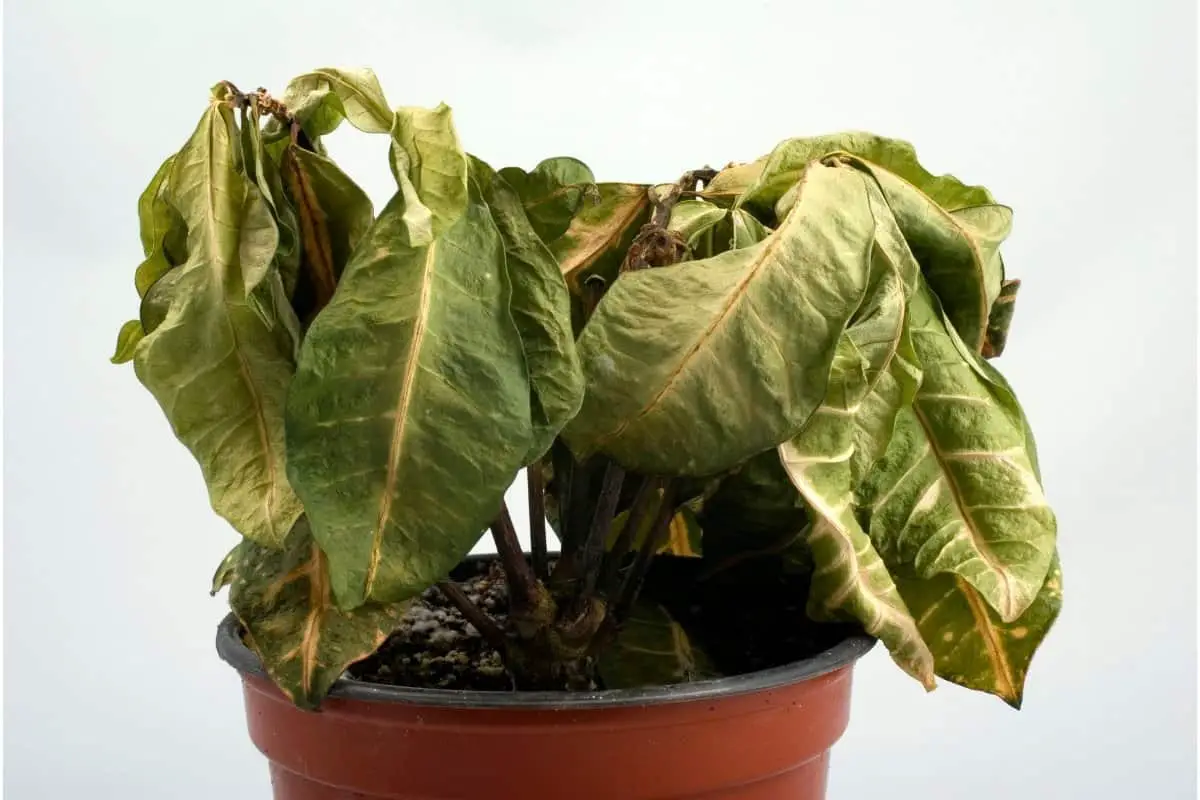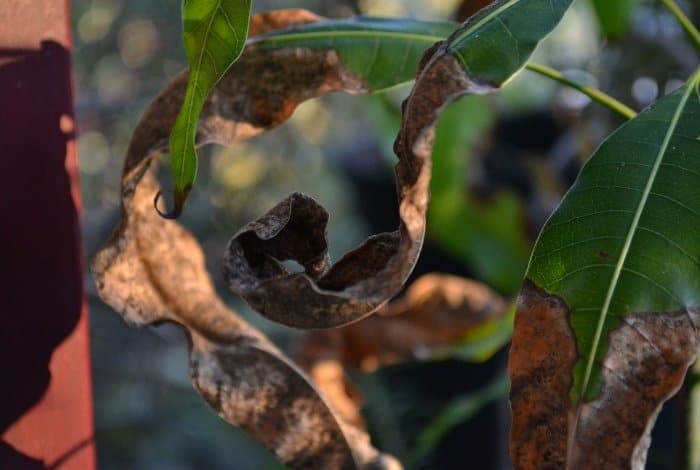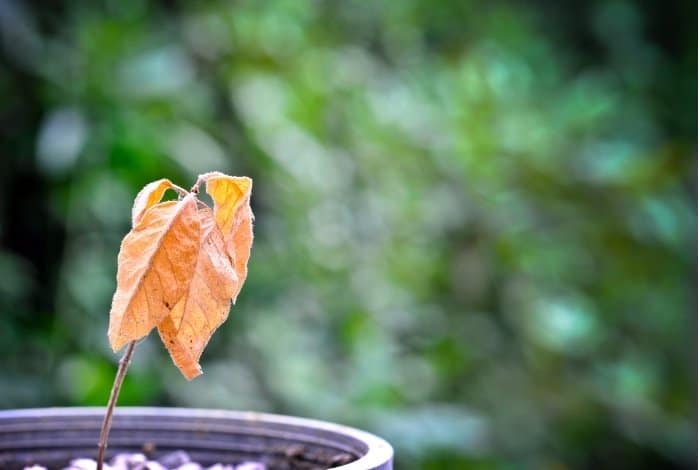Last Updated on March 2, 2023 by Griselda M.
Plant leaves dry and crispy are concerning if you don’t get to the root of the problem and rectify it. Are your plant leaves turning brown and crispy, and are you wondering what the cause is? If so, then the information in this article would be of great benefit to you.
There are various causes why the leaves of plants deteriorate. So, let’s take a look at some of the reasons your plant leaves are turning brown and crispy. We will also discuss what you can do to avoid this from happening in the future, which will keep your indoor and outdoor plants healthy and happy.
Indoor Plant Leaves Turning Brown and Crispy
When it comes to indoor plant leaves turning brown and crispy, there are a few things that you would need to consider. This type of problem can occur for several reasons, and you will witness your once thriving plant withering away with scorched foliage. For this reason, it is essential to understand why houseplants’ leaves turn brown. I mean, the cause could be anything from nutrient deficiencies, diseases, or climate extremes that are negatively affecting your houseplant.
Keep in mind that for any plant to thrive, it needs suitable living conditions. If these demands are not met, brown crispy leaves and other visible deteriorations would be evident. Additionally, the excessive use of soil amendments and growth boosters is a common cause of unattractive foliage. The bottom line is that inconsistent indoor plant care habits can cause browning leaves. Therefore, you should rethink your plant maintenance strategies and ensure that you keep to them diligently.
Unlike outdoor plants, which are usually hardier, indoor varieties require a little extra care to keep them growing their best. So, if you are an avid gardener who aims to have a lush inside garden, then a little extra time is required to keep your plant leaves looking their best. Keep in mind that browning leaves are almost definite if your maintenance schedules are inconsistent. Also, you should have a fair knowledge of the demands of the houseplant you’re growing to keep it in optimal health.
Here are a few tips to keep your indoor plants lush:
– Houseplants seek jungle-like humidity levels as it is a part of their natural growing habitat.
– If your indoor environment is dry, it is advisable to mist your plants every day to prevent the foliage from discoloring or getting damaged.
– Also, you can opt to group up houseplants or place your pots on a shallow tray filled with water and pebbles. These gestures will enhance the humidity levels and keep them elevated, which will aid your plant is growing healthily.
– The build-up of salt in soil can be damaging to houseplants. This is usually caused by the overuse of fertilizers or softened water.
– Although fertilization is an important part of indoor plant care and should be done from time to time for an ample nutrient supply, moderation is key to avoid causing the leaves to brown and crisp up.
– Keep in mind that salt buildup in the potting mix is unavoidable. This is why repotting your houseplants every couple of years using fresh soil is advised to avoid damage.
– Distilled or filtered water is best for houseplants, as softened water has the potential to turn your plant leaves brown and crispy.
Outdoor Plant Leaves Turning Brown and Crispy
Outdoor plant leaves turning brown and crispy can be an eyesore to your garden or landscape. The reason that this happens to tree leaves is often because of over or underwatering. For this reason, enhanced root development is an important factor for outdoor plants. This is because it enables them to delve deep into the earth to source water and other elements that are not available to meet their demands.
Plant leaves are most affected in this case because the water travels through the roots and stems before it reaches the leaves. If there is a shortage of supply, then reaching the leaves would be impossible. In the same way, too much water can also flaw your trees. Therefore, you often find your tree leaves turning brown and crispy.
Take heed of these tips to ensure your plant leaves remain healthy:
- It is important to inspect your outdoor plants regularly, as brown and crispy leaves are an indication of a halted supply of water and nutrients.
- If your plant roots are damaged or distressed, this can also prevent it from supplying the relevant elements to aid its growth. In this case, careful care is required to revive the plant.
- You should always use fertilizer in moderation, as excessive use may contribute to browned leaves. If you suspect this is the cause of your plant’s deterioration, you should stop fertilizing it until it fully recovers.
- Cutting back browned plant leaves and dormant stems is advised to allow for new growth. Keep in mind that dead leaves cannot be revived, so pruning them is the best option to encourage growth. A pair of scissors or garden shears would work well in this instance.
Reasons Why your Plant Leaves are Turning Brown and Crispy
When your plant leaves start to turn brown and crispy, here are the main reasons why this happens.
1. Under-Watering
When your plant does not receive enough natural water (under-watering), it will start to turn brown and crispy.
If your plant soil becomes extremely dry for a long time, the bottom side, the edges, or even the entirety of your leaves will begin to turn brown and crispy.
Solutions
The solution is to water your soil properly. Make sure your entire soil is soaked in water, but not too much. You should also prevent your plant from getting dry for too long.
If your plant is in a container, make sure there are drainage holes. Also, make sure that while watering, the excess liquid drips or drains away from below the drainage holes container. This way, you know the entire soil has gotten enough moisture.
2. Over-Watering
Watering your plant is good, but over-watering can also predispose your plant to turn brown and crispy. Overwatering will cause the rotting of roots, thereby hindering or restricting water movements all around (stem and leaves) your plants. When this happens, your plant leaves will get dehydrated and start to turn brown and crispy.
Solutions
Water your plants only when it’s needed and when you notice the soil is dry. Do not water when your soil is still moist.
3. Limited Space
Another cause of brown crispy leaves is when there is limited space for your roots to grow. This usually happens to plants that are in containers or pots.
The roots become choked up, and your plant will not be able to take up water from the root to the stem and leaves.
Solutions
You can fix the limited space problem if you re-pot in a bigger container. This way, there will be more room for water to move easily.
Stone & Beam Emerick Rustic Stoneware Planter Pot
4. Soil Problem
Loose soil that does not hold water well, such as sandy soil, can cause your plant to turn brown and crispy. The loose soil will make your plant let go of water easily, and it will eventually become deprived.
Solutions
The best solution is to enhance your soil by adding organic matter. This will help your plant soil hold more water, thereby providing sufficient moisture for your plant.
5. Too Much Fertilization
When you over-fertilize, your plant roots will be harmed; therefore, they will be unable to transport water to the stem and leaves efficiently. This will cause your plant leaves to become brown and crispy.
Solutions
Always make sure you calculate or measure the correct amount of fertilization you are applying to your plants. This way, you avoid over-fertilization, and your plant will get the right amount to thrive.
With that said, we do hope you found this information on plant leaves turning brown and crispy helpful.
Read more about Why Are My Sunflower Leaves Turning Brown – Find Out The 5 Best Answers And Save Your Sunflowers

Eunice is a gardener who loves to play in the dirt. She starts her day early in the morning, watering her plants and tending to her garden. She loves the smell of freshly cut grass and the feeling of sunshine on her back as she works. She‘s a master at creating beautiful flower arrangements and can often be found humming a tune as she tends to her plants. When she‘s not gardening, she loves to read books about nature and share her knowledge with others. Eunice loves gardening so much that she‘s even been known to talk to her plants!





